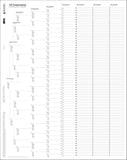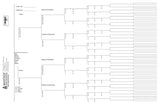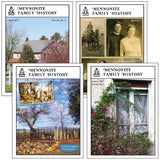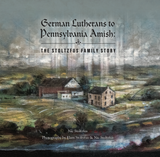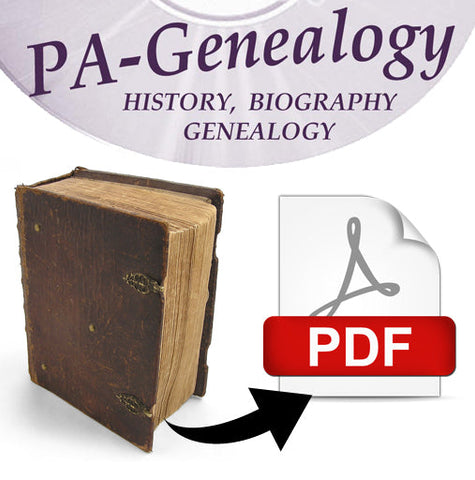
Pennsylvania German Collection #2
GM02 - Pennsylvania German Collection #2
A Defense of the Hessians (Joseph G. Rosengarten, 1899, 28 pages)
This is an excerpt from the Pennsylvania Magazine of History and Biography that was also published separately at a later date. It provides a historical background of the circumstances of the German people which lead some of them to participate in the American Revolution as Allies of the British.
The German Immigration into Pennsylvania Through the
Port of Philadelphia 1700-1775. The Redemptioners
(Frank Reid Diffenderffer, 1900, 386 pages)
This publication was written by one of the foremost authorities on German immigration. It is a discussion of the Redemptioner or Indentured servant who sold themselves to gain passage to America.
Part I - The German Immigration into Pennsylvania
Chapters:
1 - Our Sources of Information Relative to the German Immigration
2 - Causes Leading to the Migration to Pennsylvania
3 - Penn's own Description of his Province
4 - Efforts to Secure Colonists Successful
5 - The Voyage Across the Ocean
6 - Pennsylvania the Favorite Home of German Immigrants
7 - Glance at the Quarrels Between the Proprietary Governors and the Provincial Assembly
8 - Early Demand of the Germans for Naturalization
9 - The German Population of Pennsylvania
10 - Their Detractors and their Friends
11 - The Germans as Farmers
Part II - The Redemptioners
Chapters:
1 - Who and What They Were
2 - Bond Servants a Universal Custom of the Times
3 - Origin and Meaning of the Term "Redemptioner"
4 - The "Newlanders" or Soul-Sellers
5 - The Testimony of the Newspapers Concerning the Traffic in Redemptioners in the 18th Century
6 - Redemptioners or Indentured Servants not all Germans
7 - Christopher Saur's Letters to Governor Morris
8 - The Mortality of Immigrants on Shipboard
9 - The Traffic in Redemptioners in the Neighboring Colonies
10 - Argument to Show the Redemptioner System was not Wholly Evil
Redemptioners and Indentured Servants in the Colony and
Commonwealth of Pennsylvania (Karl Frederick Geiser, 1901, 127 pages)
This publication is an examination of the practice of indentured servitude which allowed many German immigrants to enter the state of Pennsylvania.
Chapters:
1 - Introduction
2 - Causes of Immigration
3 - The Number and Significance of Redemtioners and Indentured Servants
4 - Historical Sketch of Immigration
5 - The Voyage
6 - Laws and Methods of Regulating Transportation
7 - The Indenture
8 - The Runaways
9 - Punative and Marriage Regulations
10 - The Servant in the Army
11 - The Social Status of the Servant
The German and Swiss Settlements of Colonial Pennsylvania.
A Study of the So-Called Pennsylvania Dutch (Oscar Kuhns, 1901, 279 pages)
From the Preface: "The object of this book is to give a complete yet concise view of a too-much-neglected phase of American origins. The author has especially tried to be impartial, avoiding as far as possible mere rhetoric, and allowing the facts to speak for themselves. As a book of this kind can have no real value unless it is reliable, authorities have been freely quoted, even at the risk of making the number of foot-notes larger than is perhaps suited to the taste of the general public." This publication covers information pertaining to the German immigration to Pennsylvania and the contribution of these German immigrants to the development of the regions they settled. The appendix contains a list of the German and Swiss surnames and their meaning.
Studies in Pennsylvania German Family Names
(Oscar Kuhns, 1901, 45 pages)
This is an excerpt from the publication Americana Germanica Vol. 4, No. 4. It focuses on the family names of Pennsylvania Germans discussing 1) the meaning of the original German names, and 2) the changes those names underwent in America. It relates a great deal of source information on these names including an alphabetical list giving the meanings of surname parts.
The German Pioneers in Pennsylvania (George W. Richards, 1905, 31 pages)
This was an essay read before the Cliosophic Society of Lancaster, PA and the Reformed Ministerial Association of Philadelphia. This is a brief discussion of the German settlers of Pennsylvania and their part in the later development of the State and country.
The German Pioneers in Pennsylvania
(George W. Richards, 1905, 31 pages)
This is a general discussion of the German immigrants to Pennsylvania; their culture, and contribution to life in the new world.
German Religious Life in Colonial Times
(Lucy Forney Bittinger, 1906, 140 pages)
From the Preface: "The work deals with much the same subject as that of my earlier book, “The Germans in Colonial Times.” But it is specifically confined to an account of the religious life of the same period and people. A better title would have been “Church Life,” were it not that the restriction of the term “church” to the three tolerated confessions-Lutheran, Reformed, and Catholic makes this title seem to confine the subject of the work to them, whereas the story of the sects forms a large part of it, as well in importance as in bulk. It has been my aim to make the history a connected story, not following the thread of each separate denomination’s annals, but rather trying to look over the whole field and narrate the general course of ecclesiastical life among the Germans in America during the Colonial era."
Chapters:
1 - Religious Conditions in Germany
2 - The Separatists
3 - The Church People
4 - The Moravians
5 - The Methodists
6 - The German Churches During the Revolution
The Dunkers - A Sociological Interpretation
(John Lewis Gillin, 1906, 237 pages)
This publication is a history of the Dunkers [Tunkers] including their origins and life in Europe, but also their immigration to America and subsequent growth in their new land. Much of the information focuses on Pennsylvania where a large number of this faith resided.
The Life of Francis Daniel Pastorius The Founder of
Germantown (Marion Dexter Learned, 1906, 424 pages)
This is a narrative covering the life of Francis Daniel Pastorius who was a prominent religious figure in colonial Pennsylvania. He was instrumental in the foundation and growth of Germantown and its community.
The Mennonites in America (C. Henry Smith, 1909, 497 pages)
From the Introduction: "Although the story of the religious life of the Mennonites may be told in few words, yet they have been the founders of the first German colony in America and have been among the pioneers in many of the frontier settlements in the westward expansion of the American people. And for this reason their history is of interest also to the student of general American history. I have attempted therefore to trace in this volume not only the history of the Mennonite church but also the complete life story of the Mennonite people..."
Chapters:
1 - The Anabaptists
2 - Menno Simons and the Mennonites of Europe
3 - Cornelisz Pieter Plockhoy and the Mennonite Colony on the Delaware
4 - Germantown
5 - The Pequea Colony
6 - Franconia
7 - Expansion of the Pequea Colony before 1800
8 - The Amish
9 - During the Revolution
10 - The Mennonites of Ontario
11 - The Mennonites During the Nineteenth Century
1) Settlements in Ohio, Illinois, Indiana and the Western States
2) Schisms
3) The Civil War.
12 - The Immigration from Russia .
13 - The General Conference of Mennonites
The German Element in the United States
(Albert Bernhardt Faust, 1909, 1200 pages)
This book provides an extensive look into the German element of the United States, and the way it influenced American society, particularly in the states of Pennsylvania, New Jersey, New York, Virginia, Maryland, North and South Carolina, Kentucky, Tennessee, and Ohio. This is an excellent resource for researching German-American heritage.
Volume 1
Chapters:
1 - The earliest Germans in the Anglo-American colonies
2 - The first permanent German settlement at Germantown, 1683
3 - Increase in German immigration in the Eighteenth century, and its causes
4 - The first Exodus, the Palatine immigration to New York
5 - The Germans in Pennsylvania
6 - The early Germans of New Jersey and of Maryland
7 - The Germans in Virginia
8 - The Germans in North and South Carolina during the Eighteenth century
9 - German settlements before the Revolution in Georgia and in New England
10 - The location of the German settlers before 1775; Their defense of the frontier; and an estimate of their numbers
11 - The Germans as patriots and soldiers during the war of the Revolution, 1775-1783
12 - The winning of the west. I. The German settlers in Kentucky and Tennessee
13 - The winning of the west. II. The settlements of the Ohio Valley
14 - The winning of the west. III. (A) The advance of the frontier line to the Mississippi and Missouri Rivers
15 - The winning of the west. IV. The Northwest, The Southwest, and the Far West
16 - The German element in the wars of the United States during the Nineteenth century
17 - A summary view of the German immigrations of the Nineteenth century, their location, distribution, and general character
Volume 2
Chapters:
1 - An estimate of the number of persons of German blood in the population of the United States
2 - The influence of the Germans in the material development of the country
3 - German influence on the material development of the United States
4 - Political influence of the German element in the Uniter States
5 - The German influence on education in the United States
6 - Social and cultural influence of the German element
7 - Social and cultural influence of the German element
8 - Social and moral influence of the German element
History of German Immigration in the United States
and Successful German-Americans and Their Descendants
(Geo. Von Skal, 1910, 347 pages)
From the Introduction: "This work is intended to be a record of all that Germans have accomplished in the United States - a record of honest endeavor, energy, perseverance, strength and achievement. It shall, in addition, show the part that the American citizen of German blood has taken in the making of these United States, in peace and war, on the battlefield as well as in the counting house, the workshop and laboratory, in the realm of science and education or in the long fight that was necessary to extend civilization and culture over a continent. It contains a history of German immigration in the United States from the first settlements to the present day, showing what the Germans were who left the fatherland, why they came, and what they did in their new country. Every incident throwing light upon the work done by the German element has been made use of to give a complete, though concise, and impartial recital of its activity, and a description of the influence it has exerted upon the development of the Union. In the second part the biographies of many Americans of German nativity or descent are given."
Chapter Titles:
History of German Immigration in the United States
A Martyr to Liberty
The Pennsylvania Germans
The Germans During the Revolution
From the Revolution to the Year 1848
The Forty-Eighters
The Civil War and the Years Following It
From the Franco-German War to the Present Day
Conclusion
The Percentage of German Blood in the American People
Successful German-Americans and Their Descendants
Surnames Indexed:
Abbe, Ackerman, Amend, Ams, Anderson, Bahrenburg, Balser, Barbey, Baruch, Beck, Berger, Blank, Blun, Boldt, Borkel, Brandner, Brunn, Buchsbaum, Clausen, Conreid, Cordis, Demuth, Dennig, Diefendorf, Diehl, Dippel, Dittenhoefer, Drakenfeld, Dressel, Eggers, Ehret, Eichler, Eickemeyer, Eidlitz, Eimer, Endemann, Engelhard, Engelmann, Engler, Eschmann, Ewald, Feldmann, Finn, Foelker, Fornes, Frank, Freundlich, Frey, Froeb, Fromme, Gass, Gerdau, Giegerich, Gillig, Goepel, Goertz, Goldmann, Goldschmidt, Greenhut, Grill, Groll, Gross, Grossman, Haffen, Hardenbergh, Haupt, Hauser, Haussling, Hegner, Heide, Heidritter, Heine, Heinrichs, Heintz, Heitemeyer, Helwig, Hering, Herold, Heuman, Hexamer, Hohner, Holm, Hornfeck, Hottenroth, Hraba, Hupfel, Iden, Intemann, Janssen, Joseph, Juhring, Jurgens, Kahn, Karsch, Kaufmann, Kempner, Keuffel, Kiliani, Kleinert, Knopf, Koch, Koehle, Kolle, Koller, Krause, Kremer, Krug, Kuder, Kudlich, Kunstlich, Langeloth, Lankering, Lanzer, Lauterbach, Lentz, Leschziner, Lewinson, Lichtenstein, Loeb, Loewenthal, Lustgarten, Luttgen, Mack, Maier, Mayer, Mennen, Martens, Metz, Meyer, Mietz, Miller, Mischo, Mohr, Moser, Nahmmaker, Nissen, Nordeman, Oberlaender, Obermayer, Oelkers, Ordemann, Otto, Peter, Peters, Pfizer, Prieth, Rapp, Rappenbagen, Reichhelm, Reisenweber, Reisinger, Renken, Rice, Riefe, Rinckhoff, Ringe, Ritterbusch, Rothbarth, Ruppert, Schaefer, Schieren, Schiff, Schirmer, Schmidt, Schneider, Schnitzler, Schreiter, Schurz, Schwab, Seitz, Seligman, Siegel, Simon, Sohmer, Speyer, Stadler, Steenken, Steil, Steneck, Stern, Steuer, Strasbourger, Strauss, Stuhr, Sturhahn, Sulzberger, Sulzer, Sutro, Szussky, Thalman, Thun, Timken, Volk, Vom Cleff, Von Baur-Breitenfeld, Von Der Bruck, Von Glahn, Von Minden, Wagner, Wahle, Waldenberger, Waldstein, Walther, Weber, Wehrenberg, Wehrum, Weidemann, Weil, Weiler, Welte, Wesendonck, Wessell, Wicke, Windmuller, Windolph, Wischmann, Wissner, Wolfsohn, Zimmermann
Historic Background and Annals of the Swiss and
German Pioneer Settlers of Southeastern Pennsylvania
(H. Frank Eshleman, 1917, 389 pages)
"An authentic history, from original sources, of their suffering during several centuries before and especially during the two centuries following the Protestant Reformation, and of their slow migration, moved by those causes, during the last mentioned two hundred years, westward in quest of religious freedom and their happy relief in the Susquehanna and Schuylkill Valleys in the New World; with particular reference to the German-Swiss Mennonites or Anabaptists, the Amish and other non-resistant sects." The information is laid out in a timeline starting in the 11th century continuing until the late 18th century. There are many details related as to the obstacles and sufferings of religious denominations whose followers eventually settled in southeastern Pennsylvania. Most of the information is historical in nature but it is also useful for genealogical research, as many individuals are named throughout.
Surnames Indexed: (with at least 4 occurrances)
Abercrombie, Adams, Aebersold, Aeschbacher, Aeschlimann, Albert, Albright, Allen, Amman, Andrews, Anken, Appel, Arndt, Arnold, Arnot, Atkinson, Bachman, Baer, Baker, Barell, Bassler, Bauman, Baumgardner, Bausmans, Bender, Beck, Becker, Berger, Bernharts, Beyer, Binkley, Blaser, Bowman, Brackbill, Brancht, Brand, Brechbuhl, Brobst, Brons, Brown, Bucher, Buckwalter, Buhler, Bundely, Burger, Burkard, Burkey, Burkhalter, Burkhart, Burkholder, Bumgardner, Carpenter, Carter, Cartlidge, Christ, Christians, Coatman, Coningham, Conrads, Creamer, Davis, Denck, Detwiller, Difinderfer, Eberhart, Ebersole, Eby, Eckert, Egli, Engle, Erisman, Eshleman, Everling, Fahrm, Ferree, Fink, Fisher, Forry, Fox, Franciscus, Frank, Frantz, Fredericks, Frey, Funk, Garber, Gardner, Gaumann, Gerfer, Gerhart, Gochnauer, Good, Gordon, Graff, Graeff, Graybill, Groff, Gut, Haldeman, Haller, Hare, Hartman, Hellar, Hendrick, Hendricks, Hensel, Herr, Herman, Hermans, Hershey, Hess, Hiestand, Hoffer, Hoffman, Hollinger, Huber, Hupmeier, Immel, Jones, Kauffman, Kautz, Keith, Kellar, Keller, Kendig, Kieffer, King, Klein, Kline, Kolb, Krahenbuhl, Kramer, Krebs, Kreider, Kuenzi, Kuhn, Kuhns, Kurtz, Landis, Leaman, Lefever, Lehman, Lehmann, Leonard, Lesher, Lintner, Logan, Long, Longnecker, Ludwig, Luther, Luthi, Lutz, Martin, Manz, Mason, Meier, Meyer, Metzgar, Miller, Mitchell, Mittelberger, Moor, Moore, Morris, Moser, Mosser, Moyer, Muir, Muller, Musser, Musgraves, Mussleman, Myers, Mylin, Neff, Neuenchwender, Newcomer, Newhauser, Newswanger, Oberholtzers, Oberly, Pastorius, Penn, Pennypacker, Percy, Peters, Phillips, Preneman, Pupather, Ream, Reed, Reher, Reinharts, Reist, Richen, Ritter, Rohrer, Roth, Runckel, Rupp, Russel, Saphorin, Sattler, Sauder, Schaeffer, Scheider, Schenk, Schilt, Schmidt, Schmied, Schnebeli, Schneider, Schurch, Schwartz, Shaeffer, Shaffer, Shank, Shultz, Shuemaker, Shumaker, Simon, Smith, Snavely, Snyder, Spurrier, Stauffer, Stedman, Stehli, Stein, Steiner, Steinman, Steinmetz, Stettler, Stone, Stoner, Straub, Swartz, Taylor, Telner, Thomas, Thouen, Trussel, Wagner, Walters, Weaver, Weidman, Weher, Wenger, Wilson, Wise, Wissler, Witmer, Wolf, Wright, Young, Zahler, Zaug, Zellers, Ziegler, Zimmerman, Zugg, Zwingle
The Genealogical Record of the Schwenkfelder Families
(Samuel Kriebel Brecht, 1923, 1891 pages)
This is an extensive collection of historical and genealogical data dealing with the Schwenkfelders, a group who emigrated from Europe to escape religious persecution. The account begins with a history of the group and the religious beliefs that made them different from others around them. In a period of time where there were sharp divisions between the Catholic and Protestant Churches, this group experienced the ire of both sides, ultimately forcing them to leave for the New World. Information is noted about each of the times members of the group immigrated to America, these migrations falling between the years 1731 and 1737.
In addition, there is extensive material about the settlement of the group in Pennsylvania. There is burial information from several private cemeteries, and details on the burial locations of many more of the group's members. There is also data dealing with where the various members settled.
The major portion of the data is genealogical - this publication systematically traces the descendants of the original immigrants:
George Scholtz (Schultz or Shultz), Anna Krauss, Melchior Hubner (Heebner), Christoph Kribel (Kriebel), David Hubner (Heebner), Balthasar Jackel (Yeakel), Melchior Kribel (Kriebel), George Anders, George Reinwalt, Hans Wiegner, George Wiegner, David Jackel (Yeakel), Gregorius Meisther (Meschter), Christoph Reinwald, George Mentzel, Melchior Mentzel, Melchior Neuman, Tobias Hartranft, George Weiss, Caspar Heydrick, Balthasar Heydrick, Matthus Jakel (Yeakle), David Seibt (Seipt), George Heydrick, Gregorius Scholtze (Schultz), George Drescher (Dresher), Melcher Meishter (Meschter), George Scholtze (Schultz), Melchior Scholtze (Schultz), Christoph Scholtze (Schultz), Caspar John, Andreas Warmer, Hans Hubner (Heebner), David Schubert (Shoebart), Susanna Heydrick Wiegner, Ursula Hoffman, Susanna Dietrich Scholtze, Susanna Seibt Wiegner, Regina Hubner Jackel (Yeakle), Anna Reinwald Anders, Abraham Heydrick, Eva Yeakel Meschter, Abraham Beer (Beyer), Anna Yeakel Wagner, Anna Wagner (Wagener), Christopher Hubner (Heebner), Maria Beyer Krauss, and Abraham Jackel (Yeakel).
This genealogical data includes information on thousands of individuals who descended from these immigrants, in some cases extending up to the latter part of the 19th century. The last section of this publication is a highly useful every-name index which spans 150 pages.
Surnames listed: (Due to the number of names, only those with frequent appearances are listed)
Acker, Ackerman, Adams, Alderfer, Allebach, Allen, Althouse, Anders, Anderson, Andrews, Anson, Antrim, Armstrong, Arnold, Auchy, Bachman, Bailey, Baker, Barnes, Bartholomew, Baus, Bean, Beard, Bechtel, Beck, Beideman, Bender, Benfield, Benner, Berger, Bergey, Berry, Beyer, Bieler, Biles, Billman, Bittenbender, Black, Blattner, Bobb, Boggs, Bolton, Bookheimer, Boorse, Bortz, Bosler, Bossert, Bowers, Bowman, Bradley, Brant, Breisch, Brendlinger, Brey, Brinton, Brooks, Brown, Brunner, Buchanan, Buchter, Burke, Bush, Butterweck, Butz, Cain, Campbell, Carl, Carpenter, Carson, Cassel, Casselberry, Christman, Clark, Cleaver, Clemens, Clemmer, Cole, Coleman, Comstock, Conrad, Cook, Cope, Corbit, Corson, Cox, Cramer, Crawford, Cress, Cressman, Crouthamel, Custer, Dager, Dague, Dannehower, Daub, Davidheiser, Davis, Decker, Deetz, De Haven, Deischer, DeLong, Delp, Dennis, Derr, Deshler, Dettor, Dettra, Detwiler, Dickinson, Diehl, Diffenderfer, Dimmig, Dixon, Dresher, Druckenmiller, Drumheller, Dunlap, Dunn, Eberly, Ebert, Eckert, Edelman, Edwards, Eichelberger, Elliott, Ellis, Enck, Endy, Engle, Erb, Edgar, Eschbach, Evans, Everett, Faddis, Fague, Famous, Faust, Fegley, Fetterman, Fetterolf, Fisher, Fleisher, Flick, Fluck, Focht, Foster, Fox, Frank, Frantz, Frederick, Freed, Freedman, Fretz, Frey, Freyer, Frick, Fries, Fritsch, Fulmer, Funk, Gabel, Garber, Garner, Gaugler, Gehman, Geho, Geiger, Geissinger, George, Gerhard, Gery, Gilbert, Glaes, Good, Goodfellow, Gordon, Gottschall, Gotwals, Graber, Grater, Gray, Green, Gresh, Greulich, Greisemer, Groff, Gross, Grove, Grubb, Guinn, Guyer, Haas, Hackett, Hafer, Hagenbuch, Hagey, Hagy, Hahn, Haines, Hains, Hallman, Halteman, Hamilton, Harley, Harris, Harrison, Hart, Harte, Hartman, Hartranft, Hartzell, Hauck, Hawk, Heany, Heckler, Heckman, Heebner, Heilig, Heimbach, Hein, Heist, Heller, Henderson, Hendricks, Henning, Henry, Herbst, Herman, Hersh, Herster, Hess, Heydrick, Heydt, Hiestand, High, Hildebrand, Hildenbrand, Hill, Hillegass, Hiltebeitel, Hinkle, Hoffman, Hoke, Hoover, Hopfer, Horn, Horner, Houck, Howard, Huber, Hubner, Hughes, Hughson, Hunsberger, Hunsperger, Hunsicker, Hunt, Hutchinson, Ingram, Innes, Jackson, Jacobs, Jacoby, Jackel, Johnson, Jones, Kafer, Kauffman, Keck, Keehn, Keeler, Keely, Kehl, Keiper, Keisel, Keller, Kelly, Kemmerer, Kennedy, Kepler, Kerlin, Kern, Kerr, Kerver, Keylor, Keyser, Kindig, King, Klein, Kline, Knipe, Koch, Kohler, Kramer, Kratzer, Krauss, Kriebel, Krupp, Kulp, Kurtz, Landis, Laubach, Lawall, Lee, Leeser, Leh, Leidy, Leister, Lessig, Levan, Levengood, Lewis, Lindemuth, Little, Long, Longacre, Lukens, Lutz, McElwain, Mack, Madison, Mairs, Markley, Marshall, Marsteller, Martin, Mason, Matthias, Maurer, Maxwell, Meloy, Merkel, Meschter, Mest, Metz, Metzger, Meyers, Miller, Mininger, Mixsell, Mohr, Moll, Montz, Moore, Morris, Morrison, Moser, Moyer, Murphy, Nace, Nagle, Nash, Neuman, Newman, Nice, Nichols, Norris, Nunemacher, Nuss, Nyce, Oberholtzer, Odenwelder, Osborn, Ott, Palmer, Parker, Patterson, Patteson, Paxson, Pennick, Pennypacker, Peters, Phillips, Poley, Porter, Potts, Powell, Price, Printz, Rabenold, Raesly, Rahn, Rambo, Ramsey, Rapp, Raudenbush, Reed, Reese, Reiff, Reinert, Reinhart, Reinwald, Reiter, Renninger, Rex, Rhoads, Rice, Richards, Rittenhouse, Ritter, Roberts, Robinson, Rock, Rodenbach, Roeder, Roeller, Rogers, Rose, Rosenberger, Roshong, Ross, Roth, Rothenberger, Rowland, Royer, Ruckstuhl, Rudy, Russell, Ruth, Sassaman, Sauter, Savidge, Saylor, Sayres, Schaeffer, Schantz, Scheetz, Schell, Schelly, Schlicher, Scholl, Schmidt, Schneider, Schrack, Schubert, Schueck, Schuler, Schultz, Schwartz, Schwenk, Seibert, Seipt, Shaw, Shearman, Shellenberger, Sheppard, Shoemaker, Shupe, Siesholtz, Sites, Smale, Smith, Snabel, Snyder, Speer, Spencer, Springer, Steger, Stahl, Stahler, Stahlnecker, Stauffer, Steinman, Sterner, Stevens, Stewart, Stichter, Stoudt, Stover, Strauch, Stroh, Strunk, Summers, Supplee, Taggart, Taylor, Thomas, Thompson, Treichler, Trout, Trucksess, Trumbower, Trump, Turner, Tyson, Underkoffler, Urffer, Van Fossen, Wagner, Walter, Walters, Wampole, Wanner, Warner, Weaver, Weber, Weidner, Weikel, Weiss, Weit, Wells, Wentzel, Werner, Wert, White, Wieand, Wiegner, Wile, Williams, Wilson, Wilser, Wismer, Wister, Wolf, Wolfe, Wonsetler, Wood, Worth, Wright, Yeager, Yeakel, Yeakle, Yerger, Yocum, Yoder, Yost, Young, Ziegler, Zimmerman
A Collection of Upwards of 30,000 Names of German, Swiss, Dutch,
French and other Immigrants to Pennsylvania From 1727 to 1776
(I. Daniel Rupp, 1927, 522 pages)
This publication consists mostly of an extensive compilation of ship lists for European immigrants who ultimately settled in Pennsylvania. The information includes the ship name, captain, port of departure, and passenger lists for hundreds of ships which sailed from 1727 to 1776. The appendicies at the end of the book offer additional information: The Names of the first settlers of Germantown from 1683-1710, Names of early settlers of Berks, Lebanon, Montgomery & Philadelphia Counties, Swiss & German settlers in Lancaster County from 1709-1730, Names of those who accompanied Rev. Joshua Kocherthal to NY, Names of the heads of families who remained in NY, Names of the 1st Palatinates in North Carolina 1709, 1710, Names of Germans who settled in Georgia 1734-1741, etc. This 2nd edition is a revised and improved work, adding much additional information, and giving the previous information a better arrangement. The information is related both in German and in English. This is a wonderful collection of information for historical or genealogical research in Pennsylvania, especially since these records would be the first mention of these individuals in America.
The Story of the Moravian Congregation at York,
Pennsylvania (S. C. Albright, 1927, 243 pages)
This was written as a history of the Moravian Congregation formed by early settlers of York County, PA. It discusses the Moravian faith, covers the early beginnings of the church, the church's dealings during the Revolutionary War, and many other accounts from the history of this congregation in York. Among the stories recounted, many local residents who held the faith are given mention.
Chapters:
1 - The Moravians
2 - Moravian Missions
3 - Moravian Evangelization in the North American Colonies
4 - Ecclesiastical Functions and Rituals From the Early Days
5 - Pioneer Life in York County
6 - Beginnings of the Congregation at York
7 - The Gemeinhaus
8 - The Moravian Cemetery
9 - National, Congregational and Local Activities
10 - Ministerial Succession From the Revolutionary War
11 - New Hopes in a New Location
12 - Present Congregational Activities and Future Prospects
We Also Recommend


